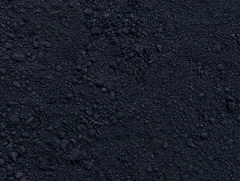Iron Oxide
| Infobox on Iron Oxide | |
|---|---|
| Example of Iron Oxide |  |
| Facts | |
| Origin | - |
| Stowage factor (in m3/t) | - |
| Humidity / moisture | - |
| Ventilation | - |
| Risk factors | - |
Iron Oxide
Description
Iron(II,III) oxide is the chemical compound with formula Fe3O4. It is one of a number of iron oxides, the others being iron(II) oxide (FeO), which is rare, and iron(III) oxide (Fe2O3) also known as hematite. It occurs in nature as the mineral magnetite. It contains both Fe2+ and Fe3+ ions and is sometimes formulated as FeO∙ Fe2O3. This iron oxide is encountered in the laboratory as a black powder. It exhibits permanent magnetism and is ferrimagnetic, but is sometimes incorrectly described as ferromagnetic. Its most extensive use is as a black pigment which is synthesised rather than being extracted from the naturally occurring mineral as the particle size and shape can be varied by the method of production.
Derivation:
a) Action of air, steam, or carbon dioxide on iron
b) Specially pure grade by precipitating hydrated ferric oxide from a solution of iron salts, dehydrating, and reducing with hydrogen
c) Occurs in nature as the mineral magnetite.
Application
Pigment, polishing compound, metallurgy, magnetic inks, and in ferrites for electronic industry, coatings for magnetic tape, catalyst.
Shipment / Storage / Risk factors
This material may be packed in jute bags without water resistant liner. Without a declaration signed by the shipper, that the cargo has been cooled and weathered for not less than eight weeks before shipment, the cargo must not be accepted.
The substance must be considered very dirty cargo and its acceptance for carriage in containers (whether in packaged form or in bulk) should be carefully considered. Container walls and doors should always be protected with plastics foil or an inner liner.
The product is liable to heat spontaneously, especially if contaminated with oil or moisture. The cargo shall be kept as dry as practicable.
Consult the IMDG (International Maritime Dangerous Goods) Code, IMSBC (International Maritime Solid Bulk) Code and applicable MSDS sheet(s) for overseas transport advice.











